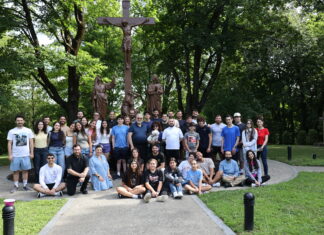MINNEAPOLIS — The University of St. Thomas School of Law, as part of its “unique mission of integrating faith and reason in the search for truth through a focus on morality and social justice,” co-organized an international conference, in partnership with the International Institute for Genocide and Human Rights Studies (A Division of the Zoryan Institute), to examine “The Armenian Genocide within the Framework of National and International Law.” The conference took place on February 5, in conjunction with the Cafesjian Family Foundation and the Ohanessian Endowment Fund for Justice and Peace Studies of the Minneapolis Foundation.
John M. Sandy, editor-in-chief of the Journal of Law and Public Policy of the University of St. Thomas, stated, “When I first heard about the Armenian Genocide from a fellow passenger on a flight to Los Angeles, and learned the enormity of it, I was shocked that I had not come across this major historical event in my education up to that time. I embarked on research on this subject, and the more I learned, the more astonished I became that this was not taught as part of American history in WWI, and the more I felt there was a great deal still to be researched, especially from a legal perspective. Thus, the idea of holding a conference for the purpose of preparing a special issue of the university’s Journal of Law and Public Policy came to be.”
Prof. Robert J. Delahunty of the Law School, who served as moderator, reaffirmed the university’s position that the conference proceeds from the understanding that the Armenian Genocide is an established fact. One of the reasons for this position is that the International Association of Genocide Scholars, the world’s foremost body of researchers in the field of genocide studies, has unanimously affirmed that “it is indisputable that the Armenian Genocide is proven history.”
Mark L. Movsesian, professor of Contract Law at St. John’s University, described how the reform movement (Tanzimat) intended to provide equality for the non-Muslim minorities in the Ottoman Empire in the 19th century, failed. This was because the ruling elite and society at large could not accept it. The resentment was twofold, a) the reforms broke the covenant between the superior protector group, Muslims and the subservient, protected groups, non-Muslim; and b) they felt the reforms were imposed by the European Powers and were considered outside interference. This helped make the mass violence of the Hamidian massacres possible, in which some 200,000 Armenians were killed. It can also be seen as a precursor to the Genocide, because the mass killings went unpunished.
Prof. Vahakn N. Dadrian, director of Genocide Research at the Zoryan Institute, an expert in history and international law, described the significance of the Allied Powers’ declaration on May 24, 1915 that they would hold personally responsible for “these new crimes of Turkey against humanity and civilization.” This set a precedent in the development of international law on crimes against humanity. He then described how the national law of the Ottoman Empire, particularly the Military Tribunals, dealt with the Armenian mass killings by prosecuting those crimes immediately after WWI.
William A. Schabas, director of the Irish Centre for Human Rights at the National University of Ireland, Galway, and currently president of the International Association of Genocide Scholars, addressed the subject of “The Retroactive Applicability of the UN Genocide Convention to the Armenian Genocide.” He affirmed that what happened to the Armenians in 1915 can properly be termed genocide, and that the actions of the Ottoman Government constituted the crime of genocide. Prosecution for this crime under the UN Genocide Convention is not likely, however, as there are no longer individuals alive to prosecute. However, given that the Turkish State is the inheritor of the Ottoman Empire, it could be possible to prosecute the Turkish State for crimes against humanity.







